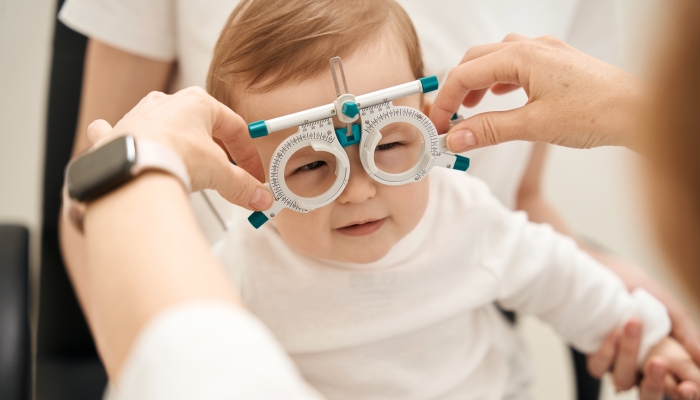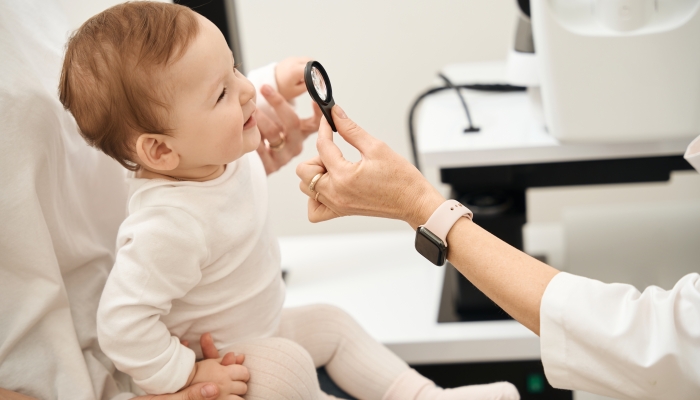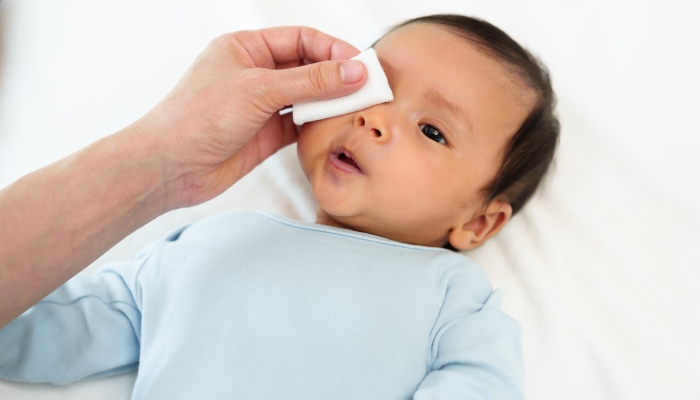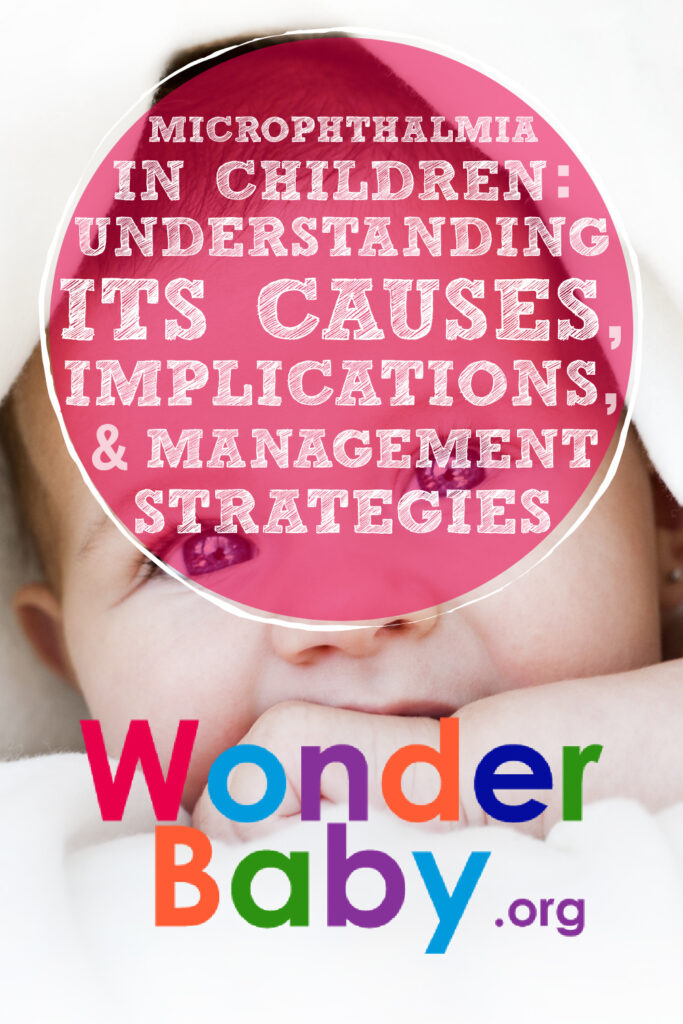Microphthalmia in Children: Understanding its Causes, Implications, and Management Strategies

- Microphthalmia is a condition where one or both of a baby’s eyes do not completely develop, and are small as a result.
- Microphthalmia can be caused by genetic disorders or environmental factors like exposure to certain medications during pregnancy.
- There’s no treatment available to correct visual impairment or severe ocular malformations caused by microphthalmia.
- Parents can help their children with mild or moderate microphthalmia by working closely with their child’s physician and utilizing early intervention programs.
Microphthalmia is a problem with the development of one or both of a baby’s eyes. This condition causes the eye or eyes to be abnormally small and usually causes mild to severe vision impairment.
Unfortunately, severe cases of microphthalmia cause complete blindness, and there’s no cure. While ocular disorders are challenging for parents and families to deal with, there are many tools and resources available for children with poor vision.
Parents can help their loved ones by learning more about microphthalmia in children and understanding its causes, implications, and management strategies.
What is Microphthalmia?
Microphthalmia is just one of many birth defects that can cause visual impairment or vision loss. Physicians may use a few different names for microphthalmia including microphthalmos or small eye syndrome. Bilateral microphthalmia affects both eyes, while unilateral microphthalmia affects only one eye.
Anophthalmia and Microphthalmia
Severe microphthalmia may be confused with anophthalmia. While they are similar and have similar causes, anophthalmia and microphthalmia are not exactly the same. Anophthalmia is more severe than microphthalmia and means that the eyeball does not develop at all. A child can be born with unilateral anophthalmia, meaning only one eye is missing, or bilateral anophthalmia, meaning that the child has no eyeball at all.
According to the CDC11. Centers for Disease Control and Prevention. Facts about Anophthalmia / Microphthalmia. Centers for Disease Control and Prevention. 2023. https://www.cdc.gov/ncbddd/birthdefects/anophthalmia-microphthalmia.html, only about 1 in 5,200 babies in the United States are born with microphthalmia or anophthalmia. About one-third of cases of anophthalmia and microphthalmia are a symptom of a more global disorder.
Causes
The experts at the National Eye Institute22. U.S. Department of Health and Human Services. Anophthalmia and Microphthalmia. National Eye Institute. 2023. https://www.nei.nih.gov/learn-about-eye-health/eye-conditions-and-diseases/anophthalmia-and-microphthalmia state that there are many different causes of microphthalmia in children. Often, the exact cause is unknown, but there are a few clear risk factors.
Risk factors include exposure to:
- Accutane
- Thalidomide
- X-rays
- Chemicals
- Illicit Drugs
- Pesticides
- Radiation
- Viruses
There are also some genetic problems that have a higher risk of eye anomalies. These include:
- Patau syndrome
- Mosaic trisomy 9
- 13q deletion syndrome
- Wolf–Hirschhorn syndrome
Anophthalmia and microphthalmia are autosomal recessive disorders, meaning that they can be passed down from parents to their children if each parent carries the gene.
Early Detection and Diagnosis

While anophthalmia and microphthalmia are birth defects that cannot be cured, early detection and diagnosis can help families prepare for the future and explore available resources for vision-impaired or blind children.
Prenatal Screening
Anophthalmia and microphthalmia may both be detected during a routine prenatal screening. Prenatal screenings typically include ultrasound imaging around 20 weeks of pregnancy to check a baby’s development and look at the internal structure of bones, organs, and other developing body parts.
Some parents choose to perform genetic testing early in pregnancy to find out whether their unborn baby has a genetic disorder or is at risk of severe birth defects. Not all genetic disorders or abnormalities can be detected by prenatal screenings.
Diagnostic Tools and Imaging Techniques
Many diagnostic tools and imaging techniques can be used to confirm a diagnosis of anophthalmia or microphthalmia.
Ultrasound
Ultrasound images can look at internal structures as well as blood flow in the body. An ultrasound performed during the pregnancy gives you and your healthcare provider a good idea of how well your baby is developing and whether or not there are any developmental problems.
Magnetic Resonance Imaging (MRI)
Magnetic resonance imaging (MRI) can give a definitive diagnosis of anophthalmia and microphthalmia. MRI machines use strong magnets to look at complex and detailed structures of the body. These images provide more information than ultrasound or CAT scan images.
A fetal MRI can be performed during pregnancy to view the structures of an unborn baby’s eye. Alternatively, an MRI scan can be performed after your baby is born.
Ocular Examination
Of course, the most straightforward way for a medical provider to diagnose microphthalmia is by performing a thorough physical examination. A pediatric ophthalmologist can examine a child’s eye socket to look for normal orbital development or facial deformity.
In addition, children should have complete vision screenings to determine the level and type of vision impairment they have.
Understanding the Implications of Microphthalmia

Children born with developmental eye defects like anophthalmia and microphthalmia will face challenges. Whether a child is born with isolated microphthalmia, meaning they are otherwise healthy, or they have other birth defects in addition to microphthalmia, they will need extra resources and support to reach their maximum level of functioning.
Visual Development
Vision impairment associated with microphthalmia can range from mild problems to complete blindness. Children born with anophthalmia have no vision on the affected side.
Associated Ocular Conditions and Syndromes
Research shows that anophthalmia and microphthalmia frequently occur concurrently with other eye problems33. Verma, A. S., & FitzPatrick, D. R.. Anophthalmia and Microphthalmia. Orphanet Journal of Rare Diseases. 2007;2(1). https://doi.org/10.1186/1750-1172-2-47. Problems commonly seen in conjunction with these issues include:
- Cataracts
- Retinal detachment
- Anterior neural tube defects
- Optic nerve dysfunction
In addition, children with anophthalmia and microphthalmia may have fused eyelids, a condition known as cryptophthalmos.
Psycho-social Effects on Children and Families
A study44. Ishtiaq, R., Chaudhary, M. H., Rana, M. A., & Jamil, A. R.. Psychosocial implications of blindness and low vision in students of a school for children with blindness. Pakistan Journal of Medical Sciences. 2016;32(2), 431–434. https://doi.org/10.12669/pjms.322.8737 of school-age children with low vision and complete blindness showed that vision problems are associated with increased depression, sadness, anxiety, and difficulty forming new friendships. Sadly, the study showed that over 50% of children with severe vision impairment report symptoms of depression.
Parents and families of children with vision problems are also emotionally impacted. Parents need to focus energy on self-care and seek out help as often as they are able. Finding a relaxing hobby outside of the home or joining a support group can help.
Educational Challenges and Necessary Support
Children with poor visual function, blindness, or developmental delays benefit greatly from early intervention, individualized education plans, counseling services, and strong social support. Children with severe vision problems often need to attend special schools for the blind and require home modifications to ensure that they are always in a safe environment.
Management Strategies

While there is no cure for anophthalmia and microphthalmia, there are ways for parents to help their children function better and protect them from further damage.
Functional Interventions
Providing a safe environment is essential for helping a child with vision loss thrive at home, school, and eventually work. Some people may need to make major home renovations to ensure the safety of their visually-impaired child.
Some safety measures that can be implemented in the home include:
- Safety railings and gates around all staircases
- Removing tripping hazards like exposed power cords and rugs
- Noise making alarm systems for hot stoves
- Street signs notifying neighbors to drive more cautiously in the area
- Tablets or cell phones designed to be used by people with vision problems
- Consistency with the placement of items around the house
Medical Interventions
Children with mild microphthalmia may benefit from vision corrective tools like eyeglasses or contact lenses.
For children with low vision in one eye, a patch may be used over the good eye to strengthen the weaker eye. This strategy is not effective for children with bilateral microphthalmia who have equal vision loss in both eyes.
Using these simple devices may be enough to help visual acuity and visual function for some children:
- Vision correction options
- Eyeglasses
- Contact lenses
Surgical Interventions
Surgery is an option for children who are diagnosed with unilateral microphthalmia, bilateral microphthalmia, and anophthalmia. While surgery does not usually restore lost vision, it can prevent further ocular tissue damage and change the appearance of congenital malformations.
One option is orbital implantation, which allows a patient to have a “normal” looking eye. Placing an implant in the eye socket can restore a child’s confidence and help them have symmetrical ocular volume on each side of their face.
There are several different types55. Schmitzer, S., Simionescu, C., Alexandrescu, C., & Burcea, M.. The Anophthalmic Socket – Reconstruction Options. Journal of medicine and life. 2014;7 Spec No. 4(Spec Iss 4), 23–29. https://www.ncbi.nlm.nih.gov/pmc/articles/PMC4962761 of orbital implants available, and parents should discuss all options with their child’s surgeon before making a decision.
Cosmetic surgery is another option used to change the facial appearance of a person with asymmetric bone growth caused by incomplete bony orbital development. Cosmetic surgery does not restore function, but it may help a child or adult feel more confident in their appearance.
For most cases of microphthalmia, cosmetic surgery involves eye socket expansion and correcting bone structure around the eye.
A child will have to wear protective eyewear for several weeks after any kind of eye surgery.
Emotional and Psychological Support
The importance of emotional and psychological support for children with vision problems cannot be overstated. With over 50% of children with blindness reporting feeling depressed and having social difficulties, it’s clear that there is a need to give these children more support.
For children, teenagers, and even young adults, the burden of seeking social support and finding resources often falls on the parents. Parents should seek out and utilize as many resources as they can to help their child adapt and cope with the challenges of vision loss.
Resources for children diagnosed with microphthalmia and their parents include:
- Counseling
- Teachers
- Individualized Education Plans
- Online support groups
- Occupational therapists
- Physical therapists
- Resources for home modifications66. Grants for Home Modification: 16 Resources for Homeowners with Disabilities. HomeAdvisor. 2021. https://www.homeadvisor.com/r/grants-for-home-modification
- Funding for children with disabilities77. Grants. Administration for Children & Families. https://www.acf.hhs.gov/grants
Long-term Outlook and Prognosis

Information from the American Academy of Ophthalmology88. Khan, A., & Traboulsi, E.. Microphthalmos, Anophthalmos, Coloboma, and Nanophthalmos (Includes CHARGE Association). American Academy of Ophthalmology. 2016. https://www.aao.org/education/disease-review/microphthalmos-anophthalmos-coloboma-nanophthalmos shows that the long-term outlook and prognosis for children with microphthalmia varies greatly on a case-by-case basis. Some children can develop nearly normal visual acuity and function, while others may suffer complete blindness and need one or two prosthetic eyes to maintain a more normal facial appearance.
Children born with microphthalmia will need frequent follow ups with their ophthalmologist, neurologist, and general pediatrician.
While there is currently no cure for anophthalmia and microphthalmia, continuing birth defects research is being conducted to determine genetic etiology of these conditions, discover new genes involved in clinical anophthalmia and microphthalmia, and create new prevention and treatment strategies for people affected by these eye disorders.
FAQs
Can microphthalmia in children lead to complete vision loss?
Microphthalmia in children may lead to complete vision loss in the affected eye. Children with unilateral microphthalmia may have perfect or near perfect vision in the affected eye, and some children maintain adequate vision in their affected eye as well.
How early can microphthalmia be diagnosed during pregnancy?
Normal orbital growth should be detectable by about 12 weeks gestation. Most parents find out about their baby’s microphthalmia during the routine 20 week ultrasound scan when most body systems are checked. There’s no way to predict the severity of vision loss a child will experience until after they are born.
How can I help my child build self-confidence and independence despite having microphthalmia?
There are many resources available for parents and children dealing with microphthalmia. Having a strong support system, enlisting the help of school counselors and therapists, and seeking out support of families dealing with similar issues can be helpful.
Children with vision problems often need the help of early intervention programs, individualized education plans, and a supportive healthcare team to overcome the challenges they face throughout life.
Some children who are missing an eye or have microphthalmia struggle with self-esteem issues related to their body image. Cosmetic surgery may be a good option for these children.
References
- Centers for Disease Control and Prevention. (2023, June 28). Facts about Anophthalmia / Microphthalmia. Centers for Disease Control and Prevention. https://www.cdc.gov/ncbddd/birthdefects/anophthalmia-microphthalmia.html
- U.S. Department of Health and Human Services. (2023, November 15). Anophthalmia and Microphthalmia. National Eye Institute. https://www.nei.nih.gov/learn-about-eye-health/eye-conditions-and-diseases/anophthalmia-and-microphthalmia
- Verma, A. S., & FitzPatrick, D. R. (2007). Anophthalmia and Microphthalmia. Orphanet Journal of Rare Diseases, 2(1). https://doi.org/10.1186/1750-1172-2-47
- Ishtiaq, R., Chaudhary, M. H., Rana, M. A., & Jamil, A. R. (2016). Psychosocial implications of blindness and low vision in students of a school for children with blindness. Pakistan Journal of Medical Sciences, 32(2), 431–434. https://doi.org/10.12669/pjms.322.8737
- Schmitzer, S., Simionescu, C., Alexandrescu, C., & Burcea, M. (2014). The Anophthalmic Socket – Reconstruction Options. Journal of medicine and life, 7 Spec No. 4(Spec Iss 4), 23–29. https://www.ncbi.nlm.nih.gov/pmc/articles/PMC4962761
- Grants for Home Modification: 16 Resources for Homeowners with Disabilities. HomeAdvisor. (2021, February 1). https://www.homeadvisor.com/r/grants-for-home-modification
- Grants. Administration for Children & Families. (n.d.). https://www.acf.hhs.gov/grants
- Khan, A., & Traboulsi, E. (2016, August 26). Microphthalmos, Anophthalmos, Coloboma, and Nanophthalmos (Includes CHARGE Association). American Academy of Ophthalmology. https://www.aao.org/education/disease-review/microphthalmos-anophthalmos-coloboma-nanophthalmos

The information WonderBaby provides is not intended to be, and does not constitute, medical or other health advice or diagnosis and should not be used as such. Always consult with a qualified medical professional about your specific circumstances.
Related Posts

Visual Impairment
The Gift of Understanding: How a Young Child Helps His Blind Father Navigate Life
When a parent is blind, it’s natural for people to wonder how their sighted child will adapt. Will they struggle to understand their parent’s needs? Will they feel burdened by...

Braille and Literacy, Toys, Visual Impairment
24 Braille Toys for Kids Who are Blind
Everything from alphabet blocks to raised line coloring pages and activity books to puzzles to card and board games... and so much more! And it's all in braille ready for...

Tactile Arts and Crafts, Visual Impairment
Using Origami to Teach Blind and Low-Vision Students Basic Shapes
If, like me, you have wondered why it is important for young students to learn about shapes, here are just a few reasons. Teaching shapes in early education provides children...